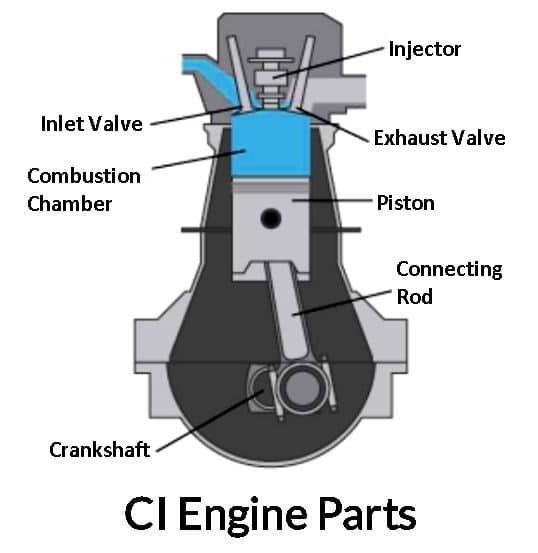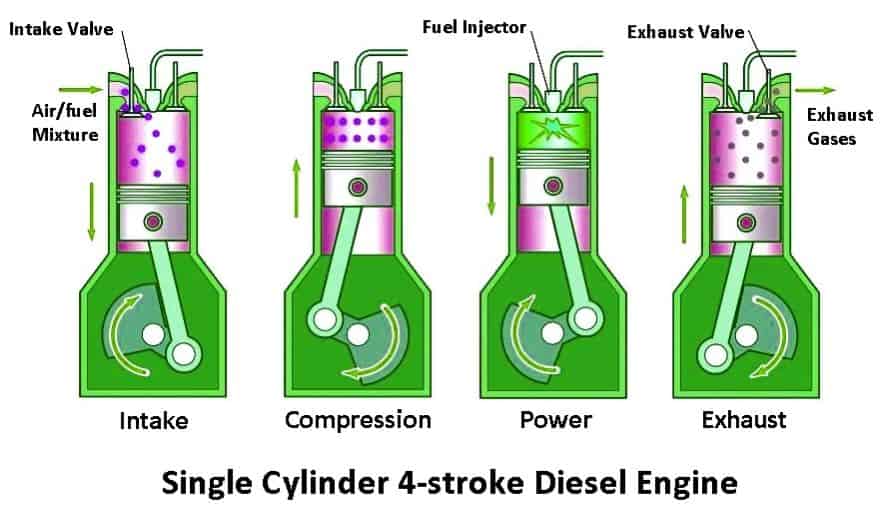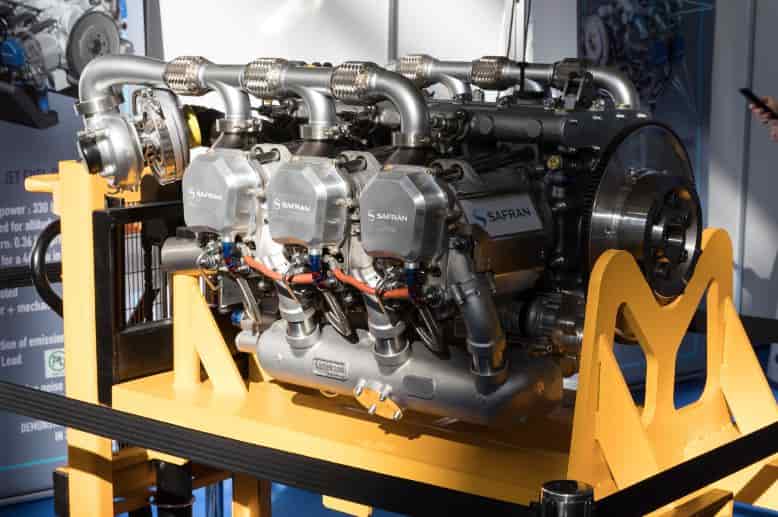Hello readers! In this post, we’ll discuss what is CI engine? Its diagram, parts, working, advantages, and applications using illustrations.
So let’s start with what is a CI engine.
What is Compression Ignition or CI Engine?
The full form of the CI engine is a compression ignition engine. A CI engine is an internal combustion engine where the use of hot compressed air ignites the fuel. When air is compressed, heat is created, which is used to ignite and burn the fuel.
In this engine, the suction stroke draws air in, which is then compressed during the compression stroke. Fuel is injected into the cylinder at the end of the compression stroke, where it ignites due to the heat of the compressed air and the power stroke starts.
The mixture is ignited without the use of any spark plugs. Compared to SI engines, these engines are more efficient. To operate, this engine needs diesel as fuel. It operates on the Diesel Cycle principle.
This type of engine typically has a compression ratio between 14:1 and 22:1. Heavy-duty automobiles, such as buses, trucks, ships, etc. use this type of engine.
You might like: Difference Between Petrol and Diesel Engines
Components of CI Engine
The following are the primary parts of a compression ignition (CI) engine:
- Injector
- Inlet valve
- Exhaust valve
- Combustion chamber
- Piston
- Connecting rod
- Crankshaft
- Camshaft

#1 Injector
During the compression of air, a fuel injector injects fuel into the cylinder, allowing it to be burned. A CI engine uses a fuel injector to atomize and inject fuel. When the combustion cycle is exactly right, the injector atomizes the fuel and forces it into the combustion chamber.
#2 Inlet Valve
When the suction stroke occurs, the air is drawn into the cylinder from the inlet valve by the suction rod.
#3 Exhaust Valve
The exhaust valve, in the ci engine, discharges the entire amount of burnt-out fuel or exhaust from the cylinder.
#4 Combustion Chamber
The combustion of fuel occurs in this chamber. The primary goal of the combustion chamber in CI engines is to quickly and efficiently mix the fuel and air to reduce ignition lag.
#5 Piston
An engine piston is a reciprocating part of an engine that performs reciprocatory motion inside a cylinder during its operation. Its primary job is to use the connecting rod to transfer the thrust force produced during the power stroke to the crankshaft.
#6 Connecting Rod
The component of a piston engine that joins the piston to the crankshaft is known as a connecting rod, also known as a “con rod.” The connecting rod, in conjunction with the crank, transforms the piston’s reciprocating motion into the crankshaft’s rotation.
#7 Crankshaft
The engine’s crankshaft transforms the force produced by combustion into rotary motion. The connecting rod converts the pistons’ linear upward and downward motion into a torque, which is then sent to the flywheel.
#8 Camshaft
The camshaft precisely controls the timing, stroke, and sequence of opening and closing the engine’s inlet and exhaust valves. The camshaft is powered by the crankshaft via gearwheels, a toothed belt, or a timing chain.
You might like: What is Engine Valves? How Do They Work?
Working of CI Engine
These engines operate on the principle that temperature rises during air compression. In these engines, only air is drawn into the cylinder via the inlet port. This will cause the piston to move from TDC to BDC.
Because of the cranking or inertia of the piston, it now begins to move towards TDC and compresses the air. This compression raises the cylinder’s internal temperature. The interior is hot enough for the fuel to ignite.
The temperature inside is high enough for the fuel to ignite. This will start the combustion process and ignite the fuel. As a result, a strong force will be produced that is used to move the piston. According to their design, CI engines primarily come in two types: two-stroke engines and four-stroke engines.
Compression ignition engines function similarly to spark ignition engines. Its operation is divided into 4 strokes as well. Here, we’ll talk about how a four-stroke CI engine operates.

#1 Suction Stroke
This stroke occurs when the piston moves from the top dead center (TDC) to the bottom dead center (BDC). The air is sucked through the inlet valve during this stroke.
#2 Compression Stroke
The air that is drawn into the cylinder during the suction stroke is compressed during this stroke. As the air is compressed, its temperature rises until it reaches the point at which diesel fuel is burned.
#3 Power Stroke
The injector injects fuel into the cylinder just before the end of the compression stroke. The heat of the air causes the fuel to ignite and combustion to occur.
The combustion of the fuel results in hot exhaust gases, which exert a strong downward thrust on the piston. The connecting rod assists the piston in turning the crankshaft. Power is produced in this stroke, hence the name “power stroke.”
#4 Exhaust Power
The piston moves upward (from BDC to TDC) during this stroke, pushing the burnt gases out of the engine cylinder via the exhaust valve.
After the exhaust stroke, all of the strokes are repeated. When a two-stroke engine is operating, one power stroke is produced for each rotation of the crankshaft. On the other hand, a four-stroke engine produces one power stroke for every two crankshaft rotations.
Below is a description of the valve’s position and the various operations carried out during a compression-ignition engine’s four-stroke cycle.
| S.no | Stroke | Inlet Valve | Exhaust valve | Operation performed |
|---|---|---|---|---|
| 1. | Suction stroke | Open | Closed | Suction of air |
| 2. | Compression stroke | Closed | Closed | Compression of air |
| 3. | Power stroke | Closed | Closed | Fuel injection, ignition, and combustion |
| 4. | Exhaust stroke | Closed | Open | Escaping of burnt gases |

You might like: What is a Single Plate Clutch?
Application
- The majority of ships use high-power two-stroke diesel engines (CI Engines).
- Small diesel engines are found in pump sets, compression machinery, air compressors, drilling rigs, and other applications.
- These engines are frequently found in vehicles like cars, trucks, and jeeps.
- Supercharged diesel engines are used in earthmovers such as loaders, excavators, and pavers.
- It is used in high-power generators.
Advantages and Disadvantages of CI Engine
Advantages
- Compared to SI engines, these engines are more efficient.
- Diesel engines or compression ignition engines have higher load-carrying capacities.
- Compared to other engines, these engines produce a high amount of power.
Disadvantages
- The weight of CI engines is greater.
- When compared to SI engines, these produce more vibration.
- It causes an offensive odor in the exhaust.
- These kinds of engines typically have higher costs.
You might like: How Does Electric Power Steering Work?
Comparison Between CI and SI Engine
Following is the comparison between CI engine and SI engine:
| CI Engine | SI Engine |
|---|---|
| Usually, diesel is used as the fuel for ci engines or diesel engines. | Typically, the SI engine, also known as a petrol engine, runs on petrol. |
| In order to ignite the fuel, the CI Engine employs the compression ignition technique. | The SI Engine ignites the fuel using the spark ignition technique. |
| In CI engine, the air/fuel mixture is injected directly into the cylinder. | The air/fuel mixture in SI engines is pre-mixed. |
| The CI engine has a high level of efficiency. | The SI engine has poor efficiency. |
| The CI engine generates more torque at a lower rpm. | Higher rpm and less torque are produced by the SI engine. |
| The CI engine produces more CO2, less NOx, and particulate matter. | The SI engine produces less CO2 while producing more NOx and particulate matter. |
| The cost and maintenance for the CI engine are higher. | The SI engine needs less maintenance and is less expensive. |
| In heavy-duty vehicles, the CI engine is frequently employed. | Light-duty vehicles frequently use SI engines. |
Closing It Up
That’s it. Thanks for reading. I hope I have covered everything about the “CI Engine” It would be helpful if you could let me know if there was anything I missed or if you have any doubts about anything I wrote.
Please share this article with your friends if you find it interesting.
Want free PDFs direct to your inbox? Then subscribe to our newsletter.
Download the PDF of this article:
You might like to read more articles in our blog:
- Understand Different Types of Clutches and How they Work
- What Are The Different Types of Suspension System?
- A Complete Guide on Steering System of a Vehicle
External Links:
It’s very important to train some people outside your country how to write like you. You are good and you are a good teacher all the time thanks
Thanks for your valuable feedback.
This was
Educational
Thanks for your feedback.
Great work!
Thanks for your feedback.